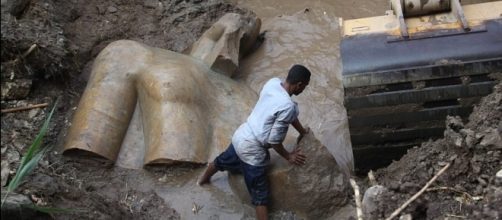A team of German and Egyptian Archaeologists made a surprising discovery in the slums of Egypt's capital city of Cairo, where they discovered a massive statue that they believe is of the ancient pharaoh Ramses Ii. The head of the statue got pulled from the mud and groundwater where it was found a few days ago by a bulldozer, with the three-ton (2,721 kilogram) torso having been pulled out yesterday. In all the statue is believed to be around eight meters (26.24 feet) tall. Archaeologists are excited about the finding, since they believe that the area around the statue is likely full of other buried treasures and antiquities.
How do they know it is Ramses II, and what will happen to the statue?
During the rule of Ramses II he was known as a great builder, so there are already massive statues of him in other places in Egypt. Some such statues of him can be seen at Luxor or Abu Simbel. Once the head of the statue got pulled out it was determined that it was the usual style that depicted Ramses II and thus is most likely him. The Ministry of Antiquities in Egypt has already said that the parts of the statue will be transported to the Egyptian Museum in central Cairo. At the museum the statue will be carefully pieced back together and restored. Finally, it will be moved to the Grand Egyptian Museum by the Giza Pyramids, which is currently scheduled to be partially opened by 2018.
Who was Ramses II?
Ramses II (c.1303-1213 BC) ruled during the New Kingdom of Egypt (c.1505-c.1077 BC). He took the throne of the country at some point in his twenties and proceeded to rule the country for more than sixty years. He is one of the more well-known and famous pharaohs that ruled over ancient Egypt. Ramses II is best known for massively expanding the reach of the country by conquering as far north as modern-day Syria and as far south as modern-day Sudan. His accomplishments in expanding the country would earn him the title "Ramses the Great" and in death he was referred to as the "Great Ancestor" by his successors.

